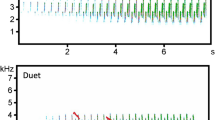Abstract
Data are presented from a study of habituated Kloss gibbons on Siberut Island, Indonesia. Male Kloss gibbons can sing at any time from 0100 to 1300 hr, but the majority of songs is concentrated in the hour before dawn. Female Kloss gibbons sing only after dawn and the song bout includes a dramatic visual display. Neither countersinging nor coordinated chorusing has been proved in either sex. Males sing before dawn as often as possible but are inhibited by wet nights and by minimum temperatures below 21.5°C; postdawn songs of both sexes are inhibited by rain. The occurrence of any particular type of song bout is independent of the occurrence of the other types. Song trees used by males and those used by females do not differ in height. Song trees emerged from the neighboring canopy more than other available trees of similar height in the gibbons’ home range. Female song trees were most abundant on the slopes and where the trees were tallest. Almost all the male’s night trees could have been used for singing from had the weather been suitable. There was a greater likelihood of the male’s traveling a long way to the day’s first fruit source on mornings when he sang before dawn than on mornings when he did not. Considerations of sound transmission through tropical rain forest reveal that the times and frequencies used for singing by Kloss gibbons are optimal for communicating with neighboring groups.
Similar content being viewed by others
References
Armstrong, E. A. (1963).A Study of Bird Song, Oxford University Press, London.
Aylor, D. (1971). Noise reduction by vegetation and ground.J. Acoust. Soc. Am. 51: 197–205.
Carpenter, C. R. (1940). A field study in Siam of the behaviour and social relations of the gibbon (Hylobates lar).Comp. Morphol. Monogr. 16: 1–212.
Chivers, D. J. (1974). The Siamang in Malaya.Contrib. Primatol. 4: 1–335.
Diamond, J. M., and Terborgh, J. W. (1968). Dual singing in New Guinea birds.Auk 85: 62–82.
Eyring, A. P. (1946). Jungle acoustics.J. Acoust. Soc. Am. 18: 257–270.
Gittins, S. P. (1978). Hark! The beautiful song of the gibbon.New Sci. 80: 832–834.
Gittins, S. P. (1979).The Behaviour and Ecology of the Agile Gibbon Hylobates agilis, Unpublished Ph.D. thesis, University of Cambridge, Cambridge.
Groves, C. P. (1972). Systematics and phylogeny of the gibbons. In Rumbaugh, D. M. (ed.),Gibbon and Siamang, Vol. I, Karger, Basel, pp. 1–89.
Haimoff, E. H. (1981). Video analysis of siamangHylobates syndactylus songs.Behaviour 78: 128–151.
Haimoff, E. H., Gittins, S. P., Whitten, A. J., and Chivers, D. J. (1982). A computer-based phylogeny of gibbons using morphological and behavioural data.Evolution (in press).
Hinde, R. A. (1970).Animal Behaviour: A Synthesis of Ethology and Comparative Psychology, 2nd ed., McGraw-Hill, New York.
Hooker, T., and Hooker, B. I. (1969). Duetting. In Hinde, R. A. (ed.),Bird Vocalizations, Cambridge University Press, Cambridge, pp. 185–205.
Lamprecht, J. (1970). Duettgesang beim Siamang,Symphalangus syndactylus (Hominoidea, Hylobatinae).Z. Tierpsychol. 27: 186–204.
MacKinnon, J. R. (1981). The spectral tarsier in North Sulawesi.Int. J. Primatol.
Marshall, J. T., and Marshall, E. R. (1976). Gibbons and their territorial songs.Science 193: 235–237.
Morton, E. S. (1975). Ecological sources of selection on avian sounds.Am. Natur. 109: 17–34.
Pollock, J. I. (1975). Field observations onIndri indri: A preliminary report. In Tattersall, I., and Sussman, R. W. (eds.),Lemur Biology, Plenum, New York, pp. 287–311.
Siegel, S. (1956).Nonparametric statistics for the behavioral sciences. McGraw-Hill, New York.
Stephens, R. W. B., and Bate, A. E. (1966).Acoustics and Vibrational Physics, Edward Arnold, London.
Tenaza, R. R. (1976). Songs, choruses and countersinging of Kloss’ gibbons (Hylobates klossii) in Siberut Island.Z. Tierpsychol. 40: 37–52.
Thorpe, W. H. (1961).Bird Song: The Biology of Vocal Communication and Expression in Birds, Cambridge University Press, Cambridge.
Thorpe, W. H., and North, M. E. W. (1965). Origin and significance of the power of vocal imitation with special reference to the antiphonal singing of birds.Nature (Lond.) 208: 219–222.
Thorpe, W. H., and North, M. E. W. (1966). Vocal imitation in the tropical Bou-bou ShrikeLaniarius aethiopicus major as a means of establishing and maintaining social bonds.Ibis 108: 432–435.
Tilson, R. L., and Tenaza, R. R. (1976). Monogamy and duetting in an Old World monkey.Nature (Lond.) 263: 320–321.
Tinbergen, N. (1951).The Study of Instinct, Clarendon Press, Oxford.
Waser, P. M., and Waser, M. S. Z. (1977). Experimental studies of primate vocalization: Specializations for long-distance propagation.Z. Tierpsychol. 43: 239–263.
Wasserman, F. E. (1977). Intra-specific acoustical interference in the white-throated sparrowZonotrichia albicollis.Anim. Behav. 25: 949–952.
Whitten, A. J. (1980).The Kloss Gibbon in Siberut Rain Forest, Unpublished Ph.D. thesis, University of Cambridge, Cambridge.
Whitten, A. J. (1982a).The Gibbons of Siberut. J. M. Dent, London.
Whitten, A. J. (1982b). The trilling handicap in Kloss gibbons. In Preuschoft, H., Creel, N., Brockelman, W. Y., and Olivers, D. J. (eds.),The Lesser Apes: Evolutionary and Behavioral Biology, Edinburgh University Press, Edinburgh (in press).
Whitten, A. J. (1982c). Numerical analysis of tropical rain forest using floristic and structural data and its application to an analysis of gibbon ranging behaviour.J. Ecol. (in press).
Whitten, A. J. (1982d). Home range use by Kloss gibbons (Hylobates klossii) on Siberut Island, Indonesia.Anim. Behav. 30: 182–198.
Whitten, A. J. (1982e). The role of ants in selection of night trees by gibbons.Biotropica (in press).
Whitten, A. J. (1982f). Preliminary observations of the Mentawai macaque on Siberut Island, Indonesia.Int. J. Primatol. (in press).
Wilson, E. O. (1975).Sociobiology: The Modern Synthesis, Belknap Press, Cambridge, Mass.
Author information
Authors and Affiliations
Rights and permissions
About this article
Cite this article
Whitten, A.J. The ecology of singing in Kloss gibbons (Hylobates klossii) on Siberut Island, Indonesia. Int J Primatol 3, 33–51 (1982). https://doi.org/10.1007/BF02693489
Received:
Revised:
Issue Date:
DOI: https://doi.org/10.1007/BF02693489




